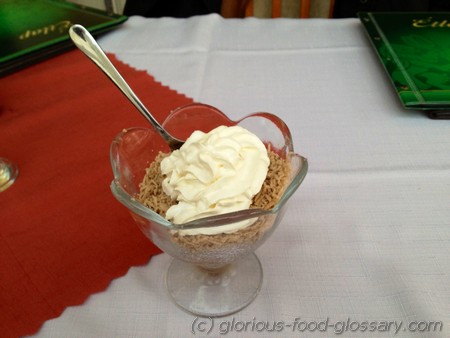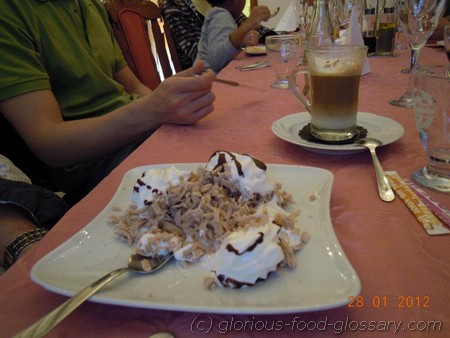Deutsch: Kastanienpüree / Español: Puré de castañas / Português: Purê de castanha / Français: Purée de châtaigne / Italiano: Purea di castagne
Gesztenyepüré is one of Hungary's signature sweets and desserts, referring to a specific style of Chestnut Purée. It is a sweet and creamy delicacy, typically made from pureed sweet chestnuts combined with sugar and a hint of rum, traditionally extruded into strands and served with a generous dollop of whipped cream (tejszínhab). This dessert is a culinary staple in Hungary, especially during the colder months and holidays, and is often considered a "must-try" item for visitors seeking authentic Hungarian confectionery.
Description
The modern preparation of Gesztenyepüré involves boiling or steaming sweet chestnuts until soft, peeling them, and then mashing them into a fine purée. This purée is subsequently sweetened, commonly flavored with vanilla, and infused with a distinct spirituous note, most often rum, which is essential to the Hungarian character of the dish. The mixture is then pressed through a special sieve or ricer, creating a noodle-like texture that is piled high in a bowl or onto a plate, resembling a small, mountainous peak. This final presentation is what links it historically to its European ancestors, specifically the Mont Blanc dessert.
Historically, the earliest recorded Chestnut Purée recipe dates back to Italy around 1475, found in a cookbook printed in Florence. Interestingly, this original iteration was reportedly yellow, possibly due to the chestnuts being pickled or preserved differently than today's versions. The French later adapted this basic recipe, popularizing their own rich and seasonal version known as Mont Blanc, named for its resemblance to the snow-covered peak of the Alps' highest mountain. The Hungarian adoption of the dessert, which led to the creation of Gesztenyepüré, occurred later, in the 18th century, a testament to Hungary’s evolving culinary landscape influenced by its European neighbors, particularly Austria and France. Today, the Hungarian version remains simpler and often more focused on the rich, earthy flavor of the chestnut, complemented by the rum and whipped cream.
Typical Applications
-
Seasonal Confectionery: Gesztenyepüré is predominantly consumed in Hungary during the chestnut harvest season, which begins in late September and extends through October, and during the winter months, making it a popular Christmas sweet.
-
Stand-Alone Dessert: The most common form is as a finished, plated dessert in restaurants, cafés, and cukrászda (confectioneries), where it is often made freshly.
-
Baking Ingredient: While the purée itself is a popular dessert, the underlying chestnut purée is also used as a filling or topping for other Hungarian pastries and cakes, adding a rich, dense flavor profile that is distinctive to the regional cuisine.
-
Frozen Format: The purée is widely available in Hungary and Central Europe in frozen, ready-to-use blocks or vacuum-sealed packs. Consumers can easily thaw these blocks, press them, and serve them at home, ensuring its accessibility year-round, despite the seasonal nature of fresh chestnuts.
Well-Known Examples
-
The Hungarian Cukrászda Experience: Nearly every traditional Hungarian confectionery, such as Gerbeaud in Budapest or smaller, regional cukrászdák, features Gesztenyepüré prominently on its menu, often serving it with a high swirl of fresh whipped cream and sometimes garnished with chocolate shavings or a sprinkle of cocoa powder.
-
The Italian Origin (1475): The first recorded recipe in the Florentine cookbook highlights the long, historical culinary legacy of chestnut purée, demonstrating its transformation over centuries from a potentially pickled, yellow-colored dish into the sweet delicacy known today.
-
The French Mont Blanc: This is perhaps the most famous international parallel. The French version, typically featuring a base of meringue, is often richer, involves a specific blend of crème de marrons (sweetened chestnut paste), and is meticulously shaped to truly resemble the iconic mountain peak, a seasonal favorite across France.
-
Central European Variants: Similar chestnut desserts exist in the neighboring countries, particularly in Austria, where it might be found in Viennese cafés, showcasing the regional spread and adaptation of the recipe across the former Austro-Hungarian Empire.
The Gesztenyepüré in Hungary was served in the traditional way, in a footed glass dessert cups


Risks and Challenges
The preparation and consumption of Gesztenyepüré present a few challenges, primarily related to sourcing, storage, and nutritional content:
-
Allergies: While chestnuts are naturally gluten-free, the inclusion of whipped cream means the dessert contains dairy. The purée itself is also often prepared in environments where cross-contamination with other allergens (nuts, wheat flour from other desserts) is possible, posing a risk for those with severe allergies.
-
Sourcing and Quality: The quality of the dessert is highly dependent on the quality of the sweet chestnuts used. Poorly harvested or improperly stored chestnuts can result in a bitter or woody taste. The initial peeling process of fresh chestnuts is also notoriously time-consuming and difficult, often leading home cooks to rely on pre-cooked or frozen purées.
-
Nutritional Density: While chestnuts are a relatively healthy, low-fat nut alternative, Gesztenyepüré is a dense dessert high in calories, primarily due to the large amount of added sugar and the generous serving of whipped cream, making it an indulgence that should be consumed in moderation.
-
Authenticity and Adulteration: A major challenge in commercial production is maintaining the traditional flavor. Some mass-produced versions may substitute high-quality rum with less expensive flavorings or use high amounts of sugar and stabilizers, diminishing the authentic, earthy taste of the chestnut.
Examples of Sentences
-
During the Christmas holidays, my family always makes a big batch of Gesztenyepüré to serve after dinner.
-
I had to buy a specialized press to achieve the fine, noodle-like strands necessary for a traditional Gesztenyepüré presentation.
-
The Gesztenyepüré at the café was so creamy and rich, with just the right amount of rum flavoring.
-
Due to the seasonal nature of the sweet chestnut harvest, many confectioneries rely on frozen purée to offer Gesztenyepüré year-round.
-
Eating a plate of Gesztenyepüré after a cold day is one of the quintessential Hungarian winter experiences.
Similar Terms
-
Mont Blanc: The French version of the chestnut purée dessert, often considered the originator of the "mountain" presentation style, typically incorporating meringue and sometimes being richer in flavor.
-
Crème de Marrons (Chestnut Cream): A French confection made from chestnuts, vanilla, and sugar, often used as a spread, a filling for pastries, or as a base for the Mont Blanc dessert. It is sweeter and smoother than the base purée used for Gesztenyepüré.
-
Marrons Glacés: Whole sweet chestnuts candied in a sugar syrup and glazed, representing a high-end, time-consuming preparation of chestnuts, often sold individually during the Christmas season.
-
Kastanienspätzle: A term often used in Austria or Southern Germany to describe the extruded, noodle-like presentation of chestnut purée, emphasizing the visual similarity to pasta-like Spätzle.
Summary
Gesztenyepüré is a celebrated Hungarian dessert consisting of a creamy purée of sweet chestnuts, typically flavored with sugar and rum, and served topped with whipped cream. Despite its roots in Italian and French culinary history, the Hungarian adaptation is a distinct and beloved seasonal confection, particularly prominent during the autumn and winter months. It stands as a powerful example of Central European culinary tradition, offering a rich, comforting, and unique flavor profile to both locals and international visitors.
--
Related Articles to the term 'Gesztenyepüré' | |
| 'Mascarpone' | ■■■■■■■ |
| Mascarpone is a rich, creamy Italian cheese made from cream and citric or acetic acid. It is a key ingredient . . . Read More | |
| 'Parfait' | ■■■■■■■ |
| Parfait is a Dessert that originated in France, traditionally made from layers of creamy mixtures such . . . Read More | |
| 'Bellini' | ■■■■■■ |
| Bellini refers to the classic Italian sparkling cocktai. It was ni was invented by Giuseppe Cipriani . . . Read More | |
| 'Xoi nuoc dua (with Recipe)' | ■■■■■■ |
| Xoi nuoc dua (with Recipe) : Xoi nuoc dua is a Vietnamese dessert made of sweet rice with coconut. . . . . Read More | |
| 'Amaretti' | ■■■■■■ |
| Amaretti refer to small, crisp, airy, meringue-like Italian almond cookies or biscuits similar to a macaroon . . . Read More | |
| 'Pastillas' | ■■■■■■ |
| Pastillas is a beloved sweet delicacy that hails from the Philippines. This article explores the definition, . . . Read More | |
| 'Erdbeer Creme Torte' | ■■■■■■ |
| Erdbeer Creme Torte, in the food context, refers to a Strawberry Cream Cake, a delightful dessert that . . . Read More | |
| 'Huckle Berry Ice Cream' | ■■■■■■ |
| Huckle Berry Ice Cream: Huckleberry Ice Cream in the food context refers to ice cream flavored with huckleberries, . . . Read More | |
| 'Egg Pie' | ■■■■■■ |
| Egg Pie in the food context refers to a popular dessert in the Philippines, similar to the classic custard . . . Read More | |
| 'Malagkit' | ■■■■■■ |
| Malagkit refers to glutinous or sticky rice in the context of Filipino cuisine. It is a type of rice . . . Read More | |
